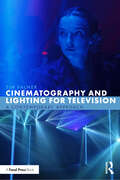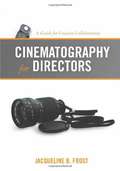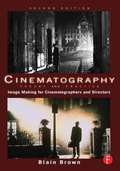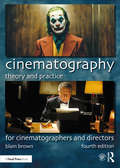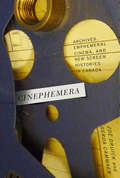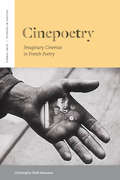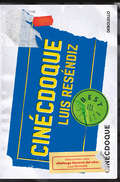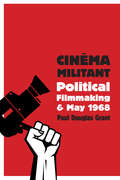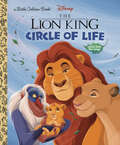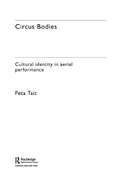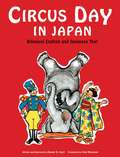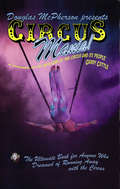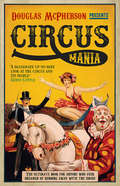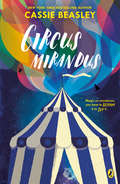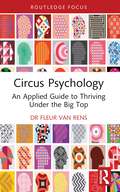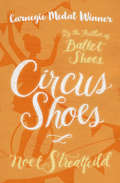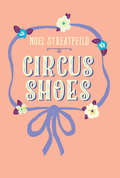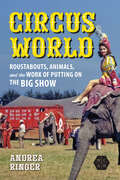- Table View
- List View
Cinematography and Lighting for Television: A Contemporary Approach
by Tim PalmerDrawing from author Tim Palmer's 30 years of experience working as a cinematographer for award-winning drama series including Killing Eve, Bad Sisters, and Line of Duty, this book is the go-to guide on how to light just about any scene a cinematographer may face when shooting a TV show.Focusing on lighting scenarios suitable for the small screen, the book is thematically organised into night and day, exteriors and interiors, and special situations including magic hour, candlelight and firelight, moonlight, torchlight, vehicle interiors, and green/blue screen, as well as providing examples from within the studio for each of these settings. Using the latest technology and developments in the practice, Palmer illustrates how cinematographers can effectively use lighting within a variety of situations. Palmer works through each example by illustrating and describing the setup with the corresponding finished film frames to show the final effect of the lighting achieved so cinematographers can easily apply and translate it to their own work.Including practical advice for working in the industry and tips for low-budget and student settings, this is an accessible and creative guide to producing visually compelling footage that translates the script to the screen. Ideal for the professional cinematographer and advanced students of cinematography looking to develop their skills.
Cinematography for Directors: A Guide for Creative Collaboration
by Jacqueline B. FrostThe essential handbook for directors and aspiring filmmakers who want to get the best visuals for their films while establishing a collaborative relationship with their cinematographer. This is the only book that focuses exclusively on the relationship between the director and cinematographer.
Cinematography, Theory and Practice: Image Making for Cinematographers and Directors (Second Edition)
by Blain BrownThere's more to being a DP than holding a light meter! With this book as your guide, you are on your way to learning not only about the equipment and technology, but also about the concepts and thought processes that will enable you to shoot professionally, efficiently, and with artistic mastery. A leading book in the field, Cinematography has been translated into many languages and is a staple at the world's top film schools. Lavishly produced and illustrated, it covers the entire range of the profession. The book is not just a comprehensive guide to current professional practice; it goes beyond to explain the theory behind the practice, so you understand how the rules came about and when it's appropriate to break them. In addition, directors will benefit from the book's focus on the body of knowledge they should share with their Director of Photography. Cinematography presents the basics and beyond, employing clear explanations of standard practice together with substantial illustrations and diagrams to reveal the real world of film production. Recognizing that professionals know when to break the rules and when to abide by them, this book discusses many examples of fresh ideas and experiments in cinematography. Covering the most up-to-date information on the film/digital interface, new formats, the latest cranes and camera support and other equipment, it also illustrates the classic tried and true methods. New! A DVD and website features hours of video footage, offering key instruction in topics such as camera basics and essentials, lighting, shooting methods, and much more. Topics include: Concepts of filmmaking, Language of the lens, Cinematic continuity, Lighting for film, digital, and HD, Exposure HD cinematography and shooting, Shooting in HD, Image control and filters, Bleach bypass processes, Lighting as storytelling, Shooting special effects, Set procedures and other issues. The DVD files are also available at http://www. taylorandfrancis. com/cw/brown-9780240812090/.
Cinematography: For Cinematographers and Directors
by Blain BrownThis book covers both the artistry and craftsmanship of cinematography and visual storytelling. Few art forms are as tied to their tools and technology as is cinematography. Take your mastery of these new tools, techniques, and roles to the next level with this cutting-edge roadmap from author and filmmaker Blain Brown. This 4th edition has been thoroughly updated throughout to include detailed information on the latest lighting and camera equipment, as well as expanded and updated discussion on the following areas: shooting on a budget, color spaces with emphasis on the new UHD standards, the decision-making process in choosing what lights and equipment to use, considerations concerning power issues, safety and what electrical supply is needed for various types of lights, an examination of the cinematographer’s role in preproduction, and much more. Topics Include: • Visual storytelling • Continuity and coverage • Cameras and digital sensors • The tools and basics of film lighting • Methods of shooting a scene • Continuity and coverage • Exposure • Color • Understanding digital images • Using linear, gamma, and log video • Image control and grading on the set • Data management and the DIT • Optics and focus • Camera movement • Set operations • Green screen, high speed, and other topics.Whether you are a student of filmmaking, someone just breaking into the business, working in the field and looking to move up the ladder, or an experienced filmmaker updating your knowledge of tools and techniques, this book provides both the artistic background of visual language and also the craft of shooting for continuity, lighting tools and methods, and the technical side of capturing images on digital or on film. The companion website (www.routledge.com/cw/brown) features additional material, including lighting demonstrations, basic methods of lighting, methods of shooting a scene, using diffusion, and other topics.
Cinematography: Image Making for Cinematographers and Directors
by Blain BrownThe world of cinematography has changed more in the last few years than it has since it has in 1929, when sound recording was introduced. New technology, new tools and new methods have revolutionized the art and craft of telling stories visually. While some aspects of visual language, lighting and color are eternal, shooting methods, workflow and cameras have changed radically. Even experienced film artists have a need to update and review new methods and equipment. These change affect not only the director of photography but also the director, the camera assistants, gaffers, and digital imaging technicians. Cinematography: Theory and Practice covers both the artistry and craftsmanship of cinematography and visual storytelling. Few art forms are as tied to their tools and technology as is cinematography. Take your mastery of these new tools, techniques, and roles to the next level with this cutting-edge roadmap from author and filmmaker Blain Brown. Whether you are a student of filmmaking, just breaking into the business, currently working in the industry and looking to move up to the next level, or an experienced professional who wants to update their knowledge of tools and techniques, this book provides both a basic introduction to these issues as well as more advanced and in-depth coverage of the subject. The companion website features additional material, including lighting demonstrations, basic methods of lighting, using diffusion and other topics. Topics Include: Visual language Visual storytelling Continuity and coverage Cameras and digital sensors Exposure techniques for film and video Color in-depth Understanding digital images Waveform monitors, vectorscopes, and test charts Using linear, gamma, and log encoded video Image control and grading on the set The tools and basics of film lighting ASC-CDL, ACES and other new methods Optics and focus Camera movement Set operations Green screen, high speed and other topics
Cinematography: Theory and Practice
by Blain BrownThere's more to being a DP than holdng a light meter! With this book as your guide, you are on your way to learning not only about the equipment and technology, but also about the concepts and thought processes that will enable you to shoot professionally, efficiently, and with artistic mastery. A leading book in the field, Cinematography has been translated into many languages and is a staple at the world's top film schools. Lavishly produced and illustrated, it covers the entire range of the profession. The book is not just a comprehensive guide to current professional practice; it goes beyond to explain the theory behind the practice, so you understand how the rules came about and when it's appropriate to break them. In addition, directors will benefit from the book's focus on the body of knowledge they should share with their Director of Photography.Cinematography presents the basics and beyond, employing clear explanations of standard practice together with substantial illustrations and diagrams to reveal the real world of film production. Recognizing that professionals know when to break the rules and when to abide by them, this book discusses many examples of fresh ideas and experiments in cinematography. Covering the most up-to-date information on the film/digital interface, new formats, the latest cranes and camera support and other equipment, it also illustrates the classic tried and true methods.
Cinephemera
by Zoë Druick Gerda CammaerWhat do digital platforms mean for cinema studies in Canada? In an era when digital media are proliferating and thousands upon thousands of clips are available online, it seems counter-intuitive to say that audio-visual history is quickly disappearing. But the two processes are actually happening in tandem. Adopting a media-archaeological approach to the history of cinema, contributors to Cinephemera cover a wide range of pressing issues relating to Canadian cinema's ephemerality, including neglected or overlooked histories, the work of found footage filmmakers, questions about access and copyright, and practices of film archiving. Spurred by rapid changes to technologies of production, viewing, and preservation, this collection showcases both leading and emerging scholars grappling with the shifting meaning of cinema as an object of study. Film historians are put in conversation with experimental filmmakers and archivists to provide renewed energy for cinema studies by highlighting common interests around the materiality and circulation of films, videos, and other old media. Considering a wide range of cases from the earliest days of silent film production to the most recent initiatives in preservation, Cinephemera exposes the richness of moving image production in Canada outside the genres of feature length narrative fiction and documentary - a history that is at risk of being lost just as it is appearing. Contributors include Andrew Burke (Winnipeg), Jason Crawford (Champlain), Liz Czach (Alberta), Seth Feldman (York), Monika Kin Gagnon (Concordia), André Habib (Montreal), Randolph Jordan (SFU), Peter Lester (Brock), Scott Mackenzie (Queen's); Louis Pelletier (Montreal), Katherine Quanz (WLU), Micky Story (New College), Charles Tepperman (Calgary), Jennifer VanderBurgh (Saint Mary's), William C. Wees (McGill), Jerry White (Dalhousie), and Christine York (Concordia).
Cinephemera: Archives, Ephemeral Cinema, and New Screen Histories in Canada
by Zoë Druick Gerda CammaerWhat do digital platforms mean for cinema studies in Canada? In an era when digital media are proliferating and thousands upon thousands of clips are available online, it seems counter-intuitive to say that audio-visual history is quickly disappearing. But the two processes are actually happening in tandem. Adopting a media-archaeological approach to the history of cinema, contributors to Cinephemera cover a wide range of pressing issues relating to Canadian cinema's ephemerality, including neglected or overlooked histories, the work of found footage filmmakers, questions about access and copyright, and practices of film archiving. Spurred by rapid changes to technologies of production, viewing, and preservation, this collection showcases both leading and emerging scholars grappling with the shifting meaning of cinema as an object of study. Film historians are put in conversation with experimental filmmakers and archivists to provide renewed energy for cinema studies by highlighting common interests around the materiality and circulation of films, videos, and other old media. Considering a wide range of cases from the earliest days of silent film production to the most recent initiatives in preservation, Cinephemera exposes the richness of moving image production in Canada outside the genres of feature length narrative fiction and documentary - a history that is at risk of being lost just as it is appearing. Contributors include Andrew Burke (Winnipeg), Jason Crawford (Champlain), Liz Czach (Alberta), Seth Feldman (York), Monika Kin Gagnon (Concordia), André Habib (Montreal), Randolph Jordan (SFU), Peter Lester (Brock), Scott Mackenzie (Queen's); Louis Pelletier (Montreal), Katherine Quanz (WLU), Micky Story (New College), Charles Tepperman (Calgary), Jennifer VanderBurgh (Saint Mary's), William C. Wees (McGill), Jerry White (Dalhousie), and Christine York (Concordia).
Cinepoetry: Imaginary Cinemas in French Poetry (Verbal Arts: Studies in Poetics)
by Christophe Wall-RomanaCinepoetry analyzes how French poets have remapped poetry through the lens of cinema for more than a century. In showing how poets have drawn on mass culture, technology, and material images to incorporate the idea, technique, and experience of cinema into writing, Wall-Romana documents the long history of cross-media concepts and practices often thought to emerge with the digital.In showing the cinematic consciousness of Mallarmé and Breton and calling for a reappraisal of the influential poetry theory of the early filmmaker Jean Epstein, Cinepoetry reevaluates the bases of literary modernism. The book also explores the crucial link between trauma and trans-medium experiments in the wake of two world wars and highlights the marginal identity of cinepoets who were often Jewish, gay, foreign-born, or on the margins.What results is a broad rethinking of the relationship between film and literature. The episteme of cinema, the book demonstates, reached the very core of its supposedly highbrow rival, while at the same time modern poetry cultivated the technocultural savvy that is found today in slams, e-poetry, and poetic-digital hybrids.
Cinesthesia: Museum Cinema and the Curated Screen (Kino-agora Ser.)
by Garrett StewartIn this profusely illustrated meditation on the phenomenon of "museum cinema," the screening of films in art museums, Garrett Stewart explores the aesthetic and formal issues raised by the proliferation of screens and films in museums in the digital era. Taking up dozens of screen artifacts over the last six decades, from 16mm loops to CCTV montage, Cinesthesia investigates in exemplary depth an array of landmark innovations from the 1960s down through the latest conceptualist exhibitions. Probing and comparative at once, it is the first study to place individual works under close formal and cultural analysis, and in steady dialogue with each other, not just as intrinsic experimental ventures but as medial challenges: challenges both to their parent forms and genres (theatrical film, broadcast TV) and to the contemplative aesthetic of museum looking. The kinetics of watching are found in this way, repeatedly and often ironically, to reroute or even derange – and ultimately to reform – the apprehending gaze. Cinesthesia includes 44 full-page colour illustrations by nearly 30 artists, including Christian Marclay, Tacita Dean, John Akomfrah, Rodney Graham, Eve Sussman and Matej Kren. "How is it – by what aesthetic criteria – that we, in ticketed public space, go to see film without going to the movies? What happens, that is, when screening times are replaced by the intermittent and elective time of transient viewing in sectored zones of a gallery layout? What new (audio-) visual parameters, in other words, are set in place when moving-image work finds itself welcomed into the environs of the proverbial 'fine' (or plastic) arts?" — Garrett Stewart
Cinesthesia: Museum Cinema and the Curated Screen (Kino-agora Ser.)
by Garrett StewartIn this profusely illustrated meditation on the phenomenon of "museum cinema," the screening of films in art museums, Garrett Stewart explores the aesthetic and formal issues raised by the proliferation of screens and films in museums in the digital era. Taking up dozens of screen artifacts over the last six decades, from 16mm loops to CCTV montage, Cinesthesia investigates in exemplary depth an array of landmark innovations from the 1960s down through the latest conceptualist exhibitions. Probing and comparative at once, it is the first study to place individual works under close formal and cultural analysis, and in steady dialogue with each other, not just as intrinsic experimental ventures but as medial challenges: challenges both to their parent forms and genres (theatrical film, broadcast TV) and to the contemplative aesthetic of museum looking. The kinetics of watching are found in this way, repeatedly and often ironically, to reroute or even derange – and ultimately to reform – the apprehending gaze. Cinesthesia includes 44 full-page colour illustrations by nearly 30 artists, including Christian Marclay, Tacita Dean, John Akomfrah, Rodney Graham, Eve Sussman and Matej Kren. "How is it – by what aesthetic criteria – that we, in ticketed public space, go to see film without going to the movies? What happens, that is, when screening times are replaced by the intermittent and elective time of transient viewing in sectored zones of a gallery layout? What new (audio-) visual parameters, in other words, are set in place when moving-image work finds itself welcomed into the environs of the proverbial 'fine' (or plastic) arts?" — Garrett Stewart
Cinécdoque
by Luis ReséndizCinécdoque es el libro que los cinéfilos necesitaban para repensar el cine comercial, reflexionar sobre sus cambios y llevar más allá de la pantalla las conquistas del séptimo arte. Con prólogo de Fernanda Solórzano. «Los textos de Cinécdoque aportan una mirada profunda a películas y fenómenos que otros, desde la pereza, consideran ligeros. Más importante, su autor es un defensor acérrimo del ensayo bien meditado. Este libro da prueba de ello y, al hacerlo, también declara: la mejor crítica cinematográfica -la única que permanece- es la que se disfruta leer.» Fernanda Solórzano, en el prólogo «Un análisis detallado sobre el blockbuster, así como una amplia disección de los elementos frecuentemente desapercibidos en su contexto [...] Si la cultura pop nutre a sociedades enteras, ¿por qué negar que también forma parte de la experiencia del ser humano?» Joyce Kauffman, Ambulante «El libro que los cinéfilos necesitaban para repensar el cine comercial, reflexionar sobre sus cambios y llevar más allá de la pantalla algunas conquistas del séptimo arte.» Lothar Torres, Ibero 90.9
Cinéma Militant: Political Filmmaking and May 1968
by Paul Douglas GrantThis history covers the filmmaking tradition often referred to as cinéma militant, which emerged in France during the events of May 1968 and flourished for a decade. While some films produced were created by established filmmakers, including Chris Marker, Jean-Luc Godard, and William Klein, others were helmed by left-wing filmmakers working in the extreme margins of French cinema. This latter group gave voice to underrepresented populations, such as undocumented immigrants (sans papiers), entry-level factory workers (ouvriers spécialisés), highly intellectual Marxist-Leninist collectives, and militant special interest groups. While this book spans the broad history of this uncharted tradition, it particularly focuses on these lesser-known figures and works and the films of Cinélutte, Les groupes medvedkine, Atelier de recherche cinématographique, Cinéthique, and the influential Marxist filmmaker Jean-Pierre Thorn. Each represent a certain tendency of this movement in French film history, offering an invaluable account of a tradition that also sought to share untold histories.
Cinéma Militant: Political Filmmaking and May 1968
by Paul Douglas GrantThis history covers the filmmaking tradition often referred to as cinéma militant, which emerged in France during the events of May 1968 and flourished for a decade. While some films produced were created by established filmmakers, including Chris Marker, Jean-Luc Godard, and William Klein, others were helmed by left-wing filmmakers working in the extreme margins of French cinema. This latter group gave voice to underrepresented populations, such as undocumented immigrants (sans papiers), entry-level factory workers (ouvriers spécialisés), highly intellectual Marxist-Leninist collectives, and militant special interest groups. While this book spans the broad history of this uncharted tradition, it particularly focuses on these lesser-known figures and works and the films of Cinélutte, Les groupes medvedkine, Atelier de recherche cinématographique, Cinéthique, and the influential Marxist filmmaker Jean-Pierre Thorn. Each represent a certain tendency of this movement in French film history, offering an invaluable account of a tradition that also sought to share untold histories.
Circle of Life (Little Golden Book)
by Courtney LovettSing along to the iconic song &“Circle of Life&” from Disney The Lion King with this beautifully illustrated Little Golden Book!Follow Simba&’s journey from confident cub, to lost runaway, to the rightful king of Pride Rock. Featuring the lyrics from the song &“Circle of Life&” written by Tim Rice and Elton John as well as beautiful illustrations of iconic movie moments, this book is perfect for fans of Disney The Lion King ages 2 to 5 and Little Golden Book collectors of all ages!Little Golden Books enjoy nearly 100% consumer recognition. They feature hot licenses, beloved classics, and new original stories . . . the classics of tomorrow.
Circus Bodies: Cultural Identity in Aerial Performance
by Peta TaitThis pioneering study is one of the major publications in the increasingly popular and largely undocumented area of circus studies. Through photographs and illustrations, Peta Tait presents an extraordinary survey of 140 years of trapeze acts and the socially changing ideas of muscular action in relation to our understanding of gender and sexuality. She questions how spectators see and enjoy aerial actions, and what cultural identities are presented by bodies in fast, physical aerial movement. Adeptly locating aerial performance within the wider cultural history of bodies and their identities, Circus Bodies explores this subject through a range of films such as Trapeze (1956) and Wings of Desire (1987) and Tait also examines live performances including: * the first trapeze performers: Léotard and the Hanlon Brothers* female celebrities; Azella, Sanyeah, black French aerialist LaLa, the infamous Leona Dare, and the female human cannonballs* twentieth-century gender benders; Barbette and Luisita Leers* the Codonas, Concellos, Gaonas, Vazquez and Pages troupes* imaginative aerial acts in Cirque de Soleil and Circus Oz productions. This book will prove an invaluable resource for all students and scholars interested in this fascinating field.
Circus Day in Japan
by Eleanor Coerr Yumi MatsunariCircus Day in Japan is the warmly-illustrated story of an exciting day spent by two Japanese children, Joji-chan and Koko-chan, at a circus. Joji-chan and Koko-chan delight at the new sights of their first circus, and young readers are gently introduced to Japanese sites and customs. The simple text and artwork provide a nostalgic window into Japanese family life in the early 1950s. The new Japanese translation makes this classic book accessible to a new generation of both English- and Japanese-speaking readers.
Circus Mania!
by Douglas McphersonA history of the circus from its origins in the Roman times, through its establishment in Western Europe, and to the modern day circus--absolutely diverse and captivating Circuses have existed since Roman times, but centuries later, the circus world has never been more diverse and captivating, the global success of Cirque du Soleil testament to its enduring and universal appeal. Traditional family circuses for kids, arty cirque-style shows for adults, circuses in tents or in theaters, circuses with animals or without, cabaret-style hybrids on the burlesque circuit--this is an expert guide to their extraordinary history and culture. The circus requires a unique type of performer, people who blend the discipline of sports stars with the razzmatazz of showbiz; itinerant but clannish entertainers who have often had circus blood in their families for generations; world class gymnasts who risk death twice daily and help take down the big top afterwards. This history offers a journey into this unique world, each chapter an access-all-areas pass to a different circus, talking to the trapeze flyers, clowns, animal trainers, and showmen about their lives, work, families, customs, and traditions.
Circus Mania: The Ultimate Book for Anyone Who Ever Dreamed of Running Away with the Circus
by Douglas McPhersonRoll up! Roll up! See the wondrous new face of Circus Mania, 250 years in the making! Full of the remarkable tales of circus life that made it a classic on its first outing. Learn about the origins of the circus from Roman times, to the colourful characters that make the circus the international phenomenon it is today. Circus Mania 2.0 is bigger, better and couldn't be timelier. Two hundred and fifty years after Philip Astley invented the circus it has never been more diverse and captivating, the global success of the spectacular Cirque du Soleil just one testament to its enduring and universal appeal. In Britain alone there are traditional family circuses for kids and arty shows for adults, circuses in tents and circuses in theatres, circuses with animals and circuses without, the Circus of Horrors for clubbers, the comedy-based Circus Hilarious and cabaret-style hybrids on the burlesque circuit and this form of entertainment is popular around the world. What all circuses have in common are the extraordinary skills, dedication and lifestyle of those involved a unique strain of performers who blend the discipline of sports stars with the razzmatazz of showbiz; itinerant entertainers who have often had circus blood in their families for generations; world-class gymnasts who risk death twice daily, serve on the tea stand in between shows and help take down the big top afterwards. Circus Mania is a journey into this unique world, each chapter an access-all-areas pass to a different circus, talking to the trapeze flyers, clowns, animal trainers and showmen about their lives, work and customs and offering insight into the development of this traditional entertainment from the earliest times.
Circus Mirandus (Fountas & Pinnell LLI Blue)
by Cassie Beasley<P>Do you believe in magic? Micah Tuttle does. Even though his awful Great-Aunt Gertrudis doesn't approve, Micah believes in the stories his dying Grandpa Ephraim tells him of the magical Circus Mirandus: the invisible tiger guarding the gates, the beautiful flying birdwoman, and the magician more powerful than any other--the Man Who Bends Light. <P>Finally, Grandpa Ephraim offers proof. The Circus is real. And the Lightbender owes Ephraim a miracle. With his friend Jenny Mendoza in tow, Micah sets out to find the Circus and the man he believes will save his grandfather. The only problem is, the Lightbender doesn't want to keep his promise. And now it's up to Micah to get the miracle he came for. <P><b> Nominee for the 2018 Young Reader's Choice Award </b> <i>(Pacific Northwest Library Association)</i>
Circus Psychology: An Applied Guide to Thriving Under the Big Top
by Fleur van RensThe lives of circus artists can be mentally and physically demanding. Circus Psychology: An Applied Guide to Thriving Under the Big Top is an evidence-based guide to nurturing the mental health of circus artists while enabling them to perform at the peak of their capacities. The book is organised into three accessible sections: mental health in circus, optimising the circus environment to facilitate thriving, and mental skills for thriving in circus. The first section introduces general mental health concepts, provides insight into the mental health of circus artists, the stress process, and the role of psychological resilience and perfectionism in mental health. The second section offers insight into motivation and engagement in circus, the features of a psychologically safe circus environment, and advice on psychologically supportive talent development environment. The final section explains, applies, and provides practice material for mental skills, including goal setting, self-talk, mental imagery, arousal regulation, and visual anticipation. Written by Dr Fleur van Rens, a circus artist and lecturer in sport psychology, this book is an essential resource for those passionate about the mental health of amateurs and professionals in the circus industry.
Circus Shoes (Shoes #2)
by Noel StreatfeildWinner of the Carnegie Medal: Threatened with being sent to separate orphanages, a brother and sister run away and join the circus When the aunt who raised them dies, 12-year-old Peter and his 11-year-old sister, Santa, face their greatest fear: being sent to separate orphanages. Vowing to stay together, they track down their only remaining relative. Uncle Gus, the black sheep of the family, has been with Cob's Circus since the war. Peter and Santa arrive just in time to see the caravans pull up. Almost before their eyes, the tents appear and an extraordinary world comes to life. They meet Alexsis Petoff and his family of acrobats; the Schmidt twins and their amazing sea lions; Lorenzo, the ornery waltzing-horse; and a trick poodle named Mis. Soon, Santa is practicing tumbling and Peter is learning to ride. They feel like they are part of the circus community. But life under the big top is hard work, and Santa and Peter will have to rise to the challenge or leave the one place they can finally call home.
Circus Shoes (Shoes #2)
by Noel StreatfeildWinner of the Carnegie Medal: Threatened with being sent to separate orphanages, a brother and sister run away and join the circus When the aunt who raised them dies, 12-year-old Peter and his 11-year-old sister, Santa, face their greatest fear: being sent to separate orphanages. Vowing to stay together, they track down their only remaining relative. Uncle Gus, the black sheep of the family, has been with Cob&’s Circus since the war. Peter and Santa arrive just in time to see the caravans pull up. Almost before their eyes, the tents appear and an extraordinary world comes to life. They meet Alexsis Petoff and his family of acrobats; the Schmidt twins and their amazing sea lions; Lorenzo, the ornery waltzing-horse; and a trick poodle named Mis. Soon, Santa is practicing tumbling and Peter is learning to ride. They feel like they are part of the circus community. But life under the big top is hard work, and Santa and Peter will have to rise to the challenge or leave the one place they can finally call home.
Circus Shoes (The Shoe Books #2)
by Noel StreatfeildFor the first time ever in the United States, the "Shoes" books are available as ebooks! Travel with the circus in Noel Streatfeild's beloved classic.Peter and Santa are orphans. They know they have an uncle, Gus, who travels with the circus, so they decide to run away to find him. And soon the traveling circus becomes their home! See the circus--the liberty horses, sea lions, dogs, and elephants--through the eyes of this young brother and sister in this classic story!Noel Streatfeild's "Shoes" books are some of the most popular of the thirty-eight books she wrote for children.
Circus World: Roustabouts, Animals, and the Work of Putting on the Big Show (Working Class in American History)
by Andrea RingerFrom the 1870s to the 1960s, circuses crisscrossed the nation providing entertainment. A unique workforce of human and animal laborers from around the world put on the show. They also formed the backbone of a tented entertainment industry that raised new questions about what constituted work and who counted as a worker. Andrea Ringer examines the industry-wide circus world--the collection of shows that traveled by rail, wagon, steamboat, and car--and the traditional and nontraditional laborers who created it. Performers and their onstage labor played an integral part in the popularity of the circus. But behind the scenes, other laborers performed the endless menial tasks that kept the show on the road. Circus operators regulated employee behavior both inside and outside the tent even as the employees themselves blurred the line between leisure and labor until, in all parts of the show, the workers could not escape their work. Illuminating and vivid, Circus World delves into the gender, class, and even species concerns within an extinct way of life.
